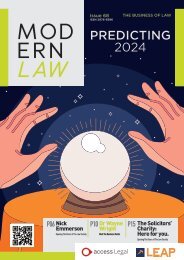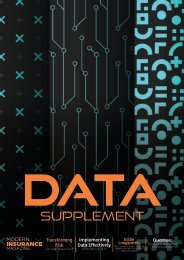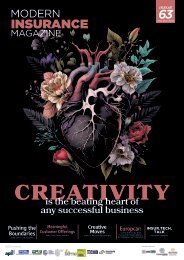Modern Insurance Magazine Issue 66
Insight: Unlocking Profitable Growth: Boosting Insurance Sales Efficiency by 18%, by Philipp Kaupke, Simon, Kucher & Partners Strategy & Marketing Consultants, Zürich Interview: Navigating a Complex Landscape by Richard Nash, Aon Interview: The True Meaning of Partnership with James Roberts, Europcar Editorial Board: Find out what our editorial board panel of experts have to say in this edition of Modern Insurance Magazine. Associations Assemble: Modern Insurance’s panel of resident associations outline the burning issues in insurance. The Fraud Board: Don’t miss our next instalment of The Fraud Board, where our growing collective of fraud experts convene to discuss the key factors affecting the fight against fraud in our industry today. FMG: Positive Cultures Attract Top Talent ParaCode: Do You Have A Healthy Relationship With Your Insurance Software Partner? Laird: Embracing Automation: Q&A with Nik Ellis Just a Thought with Eddie Longworth… ‘Groupthink’ Destroys Claims Integrity I Love Claims / ARC 360: Managing Expectations Amidst Cut-Back Cover Insurtech Insights: Interviews with Rob Newbold, Verisk; Franklin J. Manchester, SAS; Dr. Matthew Jones, Fathom; Charlie Sidoti, Innsure; Valkyrie Holmes, Faura; Dr. Maryam Golnaraghi, The Geneva Association. Insur.Tech.Talk Editorial Board: Experts from within the insurtech sector and beyond join us once more to share their unique insights
Insight: Unlocking Profitable Growth: Boosting Insurance Sales Efficiency by 18%, by Philipp Kaupke, Simon, Kucher & Partners Strategy & Marketing Consultants, Zürich
Interview: Navigating a Complex Landscape by Richard Nash, Aon
Interview: The True Meaning of Partnership with James Roberts, Europcar
Editorial Board: Find out what our editorial board panel of experts have to say in this edition of Modern Insurance Magazine.
Associations Assemble: Modern Insurance’s panel of resident associations outline the burning issues in insurance.
The Fraud Board: Don’t miss our next instalment of The Fraud Board, where our growing collective of fraud experts convene to discuss the key factors affecting the fight against fraud in our industry today.
FMG: Positive Cultures Attract Top Talent
ParaCode: Do You Have A Healthy Relationship With Your Insurance Software Partner?
Laird: Embracing Automation: Q&A with Nik Ellis
Just a Thought with Eddie Longworth… ‘Groupthink’ Destroys Claims Integrity
I Love Claims / ARC 360: Managing Expectations Amidst Cut-Back Cover
Insurtech Insights: Interviews with Rob Newbold, Verisk; Franklin J. Manchester, SAS; Dr. Matthew Jones, Fathom; Charlie Sidoti, Innsure; Valkyrie Holmes, Faura; Dr. Maryam Golnaraghi, The Geneva Association.
Insur.Tech.Talk Editorial Board: Experts from within the insurtech sector and beyond join us once more to share their unique insights
You also want an ePaper? Increase the reach of your titles
YUMPU automatically turns print PDFs into web optimized ePapers that Google loves.
INSURTECH<br />
The <strong>Insurance</strong> Industry<br />
at a Crossroads<br />
Being at a crossroads means you’ve reached a stage that requires<br />
a very important decision to go one way or the other, each with<br />
different results and consequences. This is where the insurance<br />
industry stands right now.<br />
Denise Garth,<br />
Chief Strategy Officer, Majesco<br />
Name a pressure and it’s happening. Inflation, supply chain<br />
challenges, high interest rates, lower disposable incomes<br />
and low unemployment, with growing retirements coupled<br />
with declining profitability, increased claims costs and<br />
losses, rising loss ratios, and rising reinsurance prices. All of<br />
these have combined to create a massive wedge, lifting the<br />
industry out of its seat of complacency and into a position<br />
of decision and action. Each pressure makes its own case<br />
for rethinking business operating models and technology<br />
foundations, in order to remain relevant and growing.<br />
Current business and technology frameworks no longer<br />
meet the challenges, demands, and opportunities of today’s<br />
dynamic and fast changing world, let alone the one of<br />
tomorrow. The primary challenge is the significant legacy<br />
debt generated by old operating models underpinned by<br />
multiple legacy core systems, technology architectures, and<br />
archaic business processes.<br />
Attempts to place new technologies on old foundations<br />
haven’t achieved their intended value. Legacy architecture<br />
and operational models are an unstable foundation. Their<br />
weakness is decades of modifications, myriad constraints and<br />
growing business challenges. Operating models are proving<br />
to be inefficient, unprofitable, and experience-constrained.<br />
Layered technology has added complexity that has increased<br />
costs, rather than decreasing them.<br />
The way forward must include both operational and<br />
innovative initiatives to drive transformation of today’s<br />
business model and technology foundation. This can bend<br />
the cost curve that drives profitable growth and efficiency,<br />
creating competitive differentiation for customers and<br />
managing the growing need for talent.<br />
Nearly 50% of insurance industry employees will retire by<br />
2030. Institutional knowledge and expertise is in jeopardy.<br />
Add to this the fact that 44% of Millennials don’t find<br />
an insurance career interesting, even though insurance<br />
offers great opportunities to work in a variety of avenues:<br />
underwriting, data and analytics, cutting-edge technologies,<br />
and more – all things that would seemingly appeal to this<br />
generation. These Millennial and Gen Z job expectations,<br />
including the technology they will use, places further<br />
pressure on insurers.<br />
The cost and impact of legacy debt is now catching up and<br />
pulling organizations down, certainly from a cost, speed to<br />
market, operational and talent perspective. The devastating<br />
combination of retirements and lack of interest by Millennial<br />
and Gen Z creates a real opportunity for rethinking the<br />
business model and technology foundation. Legacy business<br />
models and technology got insurers to where they are today.<br />
They can’t carry insurers safely into tomorrow.<br />
So, what needs to change? Next Gen intelligent solutions<br />
will meet the expectations of new employees, bridging the<br />
institutional knowledge gap and bending the learning curve.<br />
A groundbreaking leap in software design is making this<br />
possible, fueled by the pillars of modern innovation: cloudnative,<br />
API-first, microservices and containerization, headless,<br />
and embedded analytics - including AI and GenAI.<br />
AI and GenAI are awesome tools that have the power to<br />
revolutionize insurance — offering a tailwind for cloud-native<br />
market leaders who embrace AI and GenAI as a competitive<br />
advantage — putting distance between them and those with<br />
legacy, on-premise solutions.<br />
The insurance market is being challenged and reshaped<br />
by colliding forces. They have given the insurance industry<br />
a catalyst — a reason to refocus on transformation, drive<br />
operational optimization, and examine how insurance does<br />
business.<br />
But transformation must be more than just legacy system<br />
replacement. It must be a burning platform for strategic<br />
change of the operating model, and a flexible technology<br />
foundation that will adapt to rapid market changes, create<br />
new experiences, and allow a company’s innovators to<br />
innovate. A new foundation will decrease operational costs,<br />
improve productivity, allow marketing to tap into market<br />
opportunities that will grow the business, and keep the<br />
company prepared for change, wherever and whenever it<br />
occurs.<br />
Forward-thinking leaders recognize the crossroads,<br />
identifying the areas that intersect the operational business<br />
model with the technology foundation in order to drive<br />
optimization, growth, innovation, agility, and long-term<br />
business success. Every insurer and every transformation is<br />
unique, yet each deserves a solution that addresses every<br />
aspect of the business.<br />
Stop investing in the past, and commit to a new direction. No<br />
more patchwork solutions. Build with the future in mind.<br />
MODERN INSURANCE | 71
















